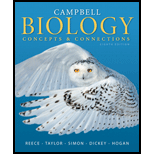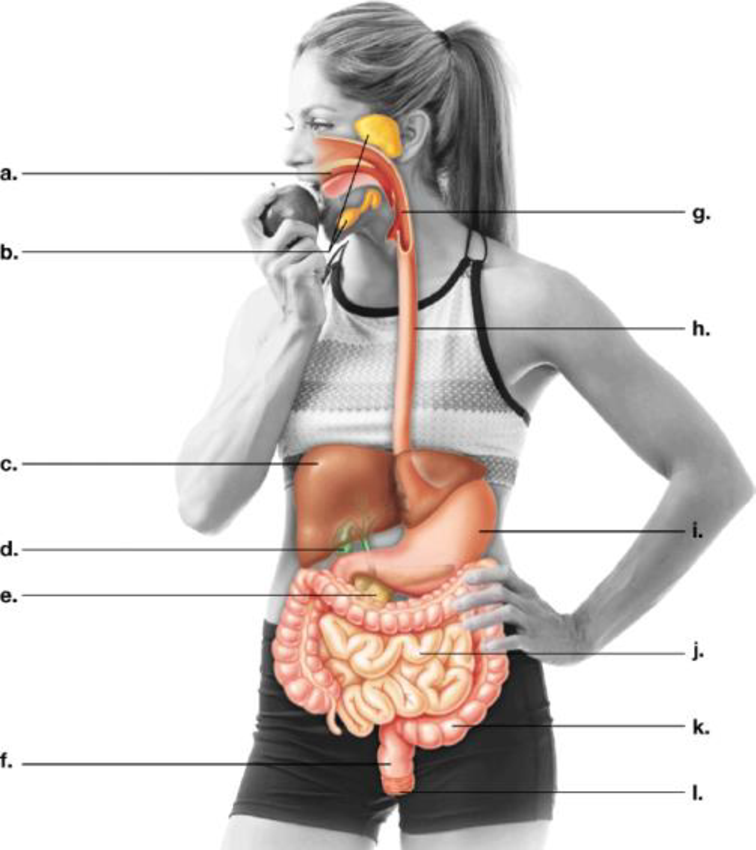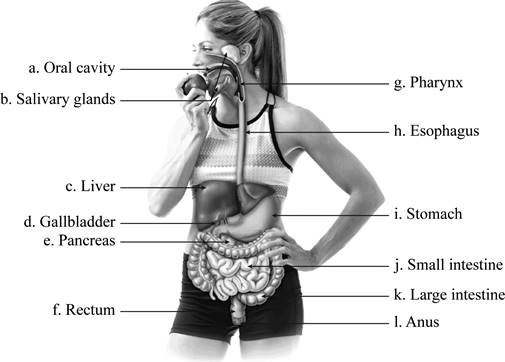
Label the parts of the human

To label: The parts of human digestive system in the figure given and indicate their functions.
Introduction: Human digestive system consists of gastrointestinal (GI) tract and accessory organs. The gastrointestinal tract is made up of mouth, esophagus, stomach, small intestine, large intestine, and anus. The accessory organs for digestion are liver, pancreas, and gallbladder. Each part of the digestive system moves ingested food through gastrointestinal tract, breaks it into small parts, so that they can be absorbed if needed or expelled out.
Answer to Problem 1CC
Pictorial representation: A labeled diagram showing the various parts of a human digestive system.

Fig.1 Human digestive system
Explanation of Solution
(a)
Correct answer: Oral cavity
Explanation: In a digestive system, the first section is ingestion and chewing of food. This is done by the oral cavity or mouth cavity. It consists of lips, cheek lining, teeth, front part of the tongue, gums, and roof of the mouth. Hence, the correct answer is oral cavity.
(b)
Correct answer: Salivary glands
Explanation: The ingested food moves through gastrointestinal tract by the process known as peristalsis. After chewing, the salivary glands form digestive juice called saliva, which moistens food to easily pass through the esophagus into the stomach. Hence, the correct answer is salivary glands.
(c)
Correct answer: Liver
Explanation: The liver’s function is to produce and secrete a digestive juice known as bile. Bile ducts carry bile from liver to gall bladder for storage, and it helps in digestion of fats. Also, the liver contributes in filtering and purifying the blood. Hence, the correct answer is liver.
(d)
Correct answer: Gall bladder
Explanation: Gall bladder is located below liver and stores bile juice. When fatty food enters the duodenum of the small intestine, the gall bladder squeezes into small intestine through bile ducts. Hence, the correct answer is gall bladder.
(e)
Correct answer: Pancreas
Explanation: Pancreas mainly forms digestive enzymes that are released into small intestine through ducts. These enzymes help in digestion of fats, proteins, and carbohydrates. Hence, the correct answer is pancreas.
(f)
Correct answer: Rectum
Explanation: Rectum is a part of the large intestine that connects the colon to the anus. It receives stool from the colon and accommodates it until it is expelled out through sphincters. Hence, the correct answer is rectum.
(g)
Correct answer: Pharynx
Explanation: Pharynx is also referred as throat in the digestive tract. It receives food from the mouth. It branches into the esophagus and the trachea. The esophagus further takes food to the stomach for digestion, and trachea carries air to the lungs. Hence, the correct answer is pharynx.
(h)
Correct answer: Esophagus
Explanation: After ingestion and chewing of food, the food is pushed to the stomach through peristaltic movement. It is carried through the esophagus. The esophagus is also known as food pipe. Hence, the correct answer is esophagus.
(i)
Correct answer: Stomach
Explanation: Stomach is a digestive organ in the abdominal cavity. It secretes digestive enzymes (breaking of large molecules), mucus (moisten), and hydrochloric acid (protection against microbes) for digestion of ingested food. Hence, the correct answer is stomach.
(j)
Correct answer: Small intestine
Explanation: Small intestine is a coiled structure and secretes digestive juices. It consists of folds that contribute in digestion and absorption of nutrients. Hence, the correct answer is small intestine.
(k)
Correct answer: Large intestine
Explanation: Large intestine consists of cecum, colon, and rectum. It helps in absorption of water from the gastrointestinal tract into the bloodstream. The unused particles are moved further into the rectum for elimination. Hence, the correct answer is large intestine.
(l)
Correct answer: Anus
Explanation: Anus is the last part of the digestive system. It is the external opening at the end of rectum for elimination of feces from the body. Defecation is controlled by two sphincters namely internal and external anal sphincters. Hence, the correct answer is anus.
Want to see more full solutions like this?
Chapter 21 Solutions
Campbell Biology: Concepts & Connections (8th Edition)
- Explain down bellow what happens to the cell in pictures not in words: Decreased pH in mitochondria Increased ATP Decreased pH in cytosol Increased hydrolysis Decreasing glycogen and triglycerides Increased MAP kinase activity Poor ion transport → For each one:→ What normally happens?→ What is wrong now?→ How does it mess up the cell?arrow_forward1.) Community Diversity: The brown and orange line represent two different plant communities. a. Which color represents the community with a higher species richness? b. Which color represents the community with a higher species evenness? Relative abundance 0.1 0.04 0.001 2 4 6 8 10 12 14 16 18 20 22 24 Rank abundance c. What is the maximum value of the Simpson's diversity index (remember, Simpson's index is D = p², Simpson's diversity index is 1-D)? d. If the Simpson's diversity index equals 1, what does that mean about the number of species and their relative abundance within community being assessed?arrow_forward1.) Community Diversity: The brown and orange line represent two different plant communities. a. Which color represents the community with a higher species richness? b. Which color represents the community with a higher species evenness? Relative abundance 0.1 0.04 0.001 2 4 6 8 10 12 14 16 18 20 22 24 Rank abundance c. What is the maximum value of the Simpson's diversity index (remember, Simpson's index is D = p², Simpson's diversity index is 1-D)? d. If the Simpson's diversity index equals 1, what does that mean about the number of species and their relative abundance within community being assessed?arrow_forward
- what measures can a mother to take to improve the produce of her to milk to her newborn baby ?arrow_forward1. Color the line that represents all ancestors of the Eastern white pine tree green (but only the ancestral line NOT shared with other organisms) 2. Oncle the last common ancestor of the Colorado blue spruce tree and Eastern white pine tree. 3. Put a box around the last common ancestor of the sugar maple tree and the dogwood tree. 4. Put a triangle around the last common ancestor of the red pine tree and the american holly bush. 5. Color the line that represents all ancestors of the Ponderosa pine tree red (including all shared ancestors). 6. Color the line that represents all ancestors of the American elm tree blue (including all shared ancestors). 7 Color the line that represents all ancestors of the Sabal palm tree purple (including all shared ancestors) 8. Using a yellow highlighter or colored pencil, circle the clade that includes all pine trees. 9. Using a orange highlighter or colored pencil, circle the clade that includes all gymnosperms 10. Can you tell…arrow_forwardYou have been hired as a public relations specialist to give invertebrates a good name. After all, they are much more than just creepy crawly bugs! Your first task though is to convince yourself that is true. The best way to do that is to start close to home. Find something in your house that is a product obtained directly from an invertebrate or only due to an invertebrate’s actions. Describe the product, its function and utility, as well as any human manufactured alternatives. Be sure to highlight the advantages of obtaining this directly from nature. Keep in mind, a product can be something you use, wear, eat, or enjoy for its visual appeal.arrow_forward
- Use the following tree diagram to answer Questions #8-10. 8) Which of the following two animals are the most closely related based on the tree to the left? a) Pig and camel b) Hippo and pig c) Deer and cow 9) CIRCLE on the tree diagram where the common ancestor between a hippo and a cow is. 10) Put a SQUARE on the tree diagram where the common ancestor between a pig and a peccary is.arrow_forwardExplain: Healthy Cell Function Overview→ Briefly describe how a healthy cell usually works: metabolism (ATP production), pH balance, glycogen storage, ion transport, enzymes, etc. Gene Mutation and Genetics Part→ Focus on the autosomal recessive mutation and explain: How gene mutation affects the cell. How autosomal inheritance works. Compare the normal and mutated gene sequences simply. → Talk about possible consequences of a faulty hydrolytic enzyme.arrow_forwardCan you fill out those termsarrow_forward
- Explain down bellow what happens to the cell: Decreased pH in mitochondria Increased ATP Decreased pH in cytosol Increased hydrolysis Decreasing glycogen and triglycerides Increased MAP kinase activity Poor ion transport → For each one:→ What normally happens?→ What is wrong now?→ How does it mess up the cell?arrow_forwardAn 1100 pound equine patient was given 20 mg/kg sucralfate 3 times a day, 2.8 mg/kg famotidine twice a day, and 10mg/kg doxycycline twice a day. Sucralfate comes as a 1 gm tablet, famotidine as 20 mg tablets, and doxycycline as 100mg tablets. All are in bottles of 100 tablets.How many total mg are needed for the patient and how many tablets of each would be needed to provide each dose?How many bottles of each would be needed to have available if this patient were to be on this drug regimen for 5 days?arrow_forwardThe patient needs a solution of 2.5% dextrose in Lactated Ringer’s solution to run at 75 ml/hr for at least the next 12hours. LRS comes in fluid bags of 500 ml, 1 Liter, 3 Liters and 5 Liters. How can a 2.5% solution be made by adding50% dextrose to the LRS?arrow_forward
 Human Biology (MindTap Course List)BiologyISBN:9781305112100Author:Cecie Starr, Beverly McMillanPublisher:Cengage Learning
Human Biology (MindTap Course List)BiologyISBN:9781305112100Author:Cecie Starr, Beverly McMillanPublisher:Cengage Learning Biology 2eBiologyISBN:9781947172517Author:Matthew Douglas, Jung Choi, Mary Ann ClarkPublisher:OpenStax
Biology 2eBiologyISBN:9781947172517Author:Matthew Douglas, Jung Choi, Mary Ann ClarkPublisher:OpenStax Concepts of BiologyBiologyISBN:9781938168116Author:Samantha Fowler, Rebecca Roush, James WisePublisher:OpenStax College
Concepts of BiologyBiologyISBN:9781938168116Author:Samantha Fowler, Rebecca Roush, James WisePublisher:OpenStax College Human Physiology: From Cells to Systems (MindTap ...BiologyISBN:9781285866932Author:Lauralee SherwoodPublisher:Cengage Learning
Human Physiology: From Cells to Systems (MindTap ...BiologyISBN:9781285866932Author:Lauralee SherwoodPublisher:Cengage Learning





